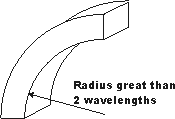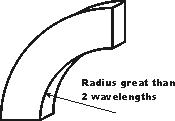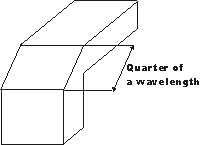Waveguide Bends
Details of RF waveguide bends allowing changes in the direction of the transmission line - waveguide E bend and waveguide H bend.
Home » Antennas & Propagation » this page
Waveguide Tutorial Includes:
Waveguide basics
Waveguide modes
Waveguide impedance & matching
Waveguide cut-off-frequency
Waveguide flanges
Waveguide junctions
Waveguide bends
Flexible waveguide
Waveguide types & sizes
Waveguide is normally rigid, except for flexible waveguide, and therefore it is often necessary to direct the waveguide in a particular direction. Using waveguide bends and twists it is possible to arrange the waveguide into the positions required.
When using waveguide bends and waveguide twists, it is necessary to ensure the bending and twisting is accomplished in the correct manner otherwise the electric and magnetic fields will be unduly distorted and the signal will not propagate in the manner required causing loss and reflections. Accordingly waveguide bend and waveguide twist sections are manufactured specifically to allow the waveguide direction to be altered without unduly destroying the field patterns and introducing loss.
Types of waveguide bend
There are several ways in which waveguide bends can be accomplished. They may be used according to the applications and the requirements.
- Waveguide E bend
- Waveguide H bend
- Waveguide sharp E bend
- Waveguide sharp H bend
Each type of bend is achieved in a way that enables the signal to propagate correctly and with the minimum of disruption to the fields and hence to the overall signal.
Ideally the waveguide should be bent very gradually, but this is normally not viable and therefore specific waveguide bends are used.
Most proprietary waveguide bends are common angles - 90° waveguide bends are the most common by far.
Waveguide E bend
This form of waveguide bend is called an E bend because it distorts or changes the electric field to enable the waveguide to be bent in the required direction.

To prevent reflections this waveguide bend must have a radius greater than two wavelengths.
Waveguide H bend
This form of waveguide bend is very similar to the E bend, except that it distorts the H or magnetic field. It creates the bend around the thinner side of the waveguide.

As with the E bend, this form of waveguide bend must also have a radius greater than 2 wavelengths to prevent undue reflections and disturbance of the field.
Waveguide sharp E bend
In some circumstances a much shorter or sharper bend may be required. This can be accomplished in a slightly different manner. The techniques is to use a 45° bend in the waveguide. Effectively the signal is reflected, and using a 45° surface the reflections occur in such a way that the fields are left undisturbed, although the phase is inverted and in some applications this may need accounting for or correcting.

Waveguide sharp H bend
This for of waveguide bend is the same as the sharp E bend, except that the waveguide bend affects the H field rather than the E field.

Waveguide twists
There are also instances where the waveguide may require twisting. This too, can be accomplished. A gradual twist in the waveguide is used to turn the polarisation of the waveguide and hence the waveform.
In order to prevent undue distortion on the waveform a 90° twist should be undertaken over a distance greater than two wavelengths of the frequency in use. If a complete inversion is required, e.g. for phasing requirements, the overall inversion or 180° twist should be undertaken over a four wavelength distance.
Waveguide bends and waveguide twists are very useful items to have when building a waveguide system. Using waveguide E bends and waveguide H bends and their srap bend counterparts allows the waveguide to be turned through the required angle to meet the mechanical constraints of the overall waveguide system. Waveguide twists are also useful in many applications to ensure the polarisation is correct.
 Written by Ian Poole .
Written by Ian Poole .
Experienced electronics engineer and author.
More Antenna & Propagation Topics:
EM waves
Radio propagation
Ionospheric propagation
Ground wave
Meteor scatter
Tropospheric propagation
Antenna basics
Cubical quad
Dipole
Discone
Ferrite rod
Log periodic antenna
Parabolic reflector antenna
Phased array antennas
Vertical antennas
Yagi
Antenna grounding
Installation guidelines
TV antennas
Coax cable
Waveguide
VSWR
Antenna baluns
MIMO
Return to Antennas & Propagation menu . . .




